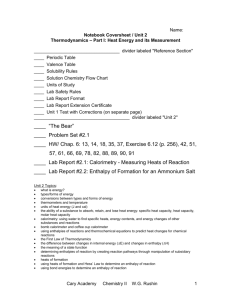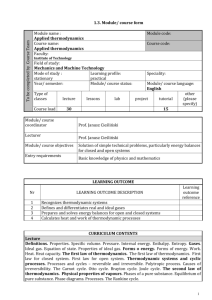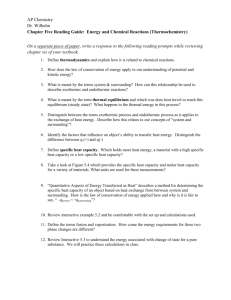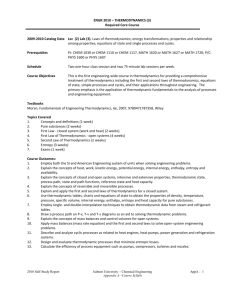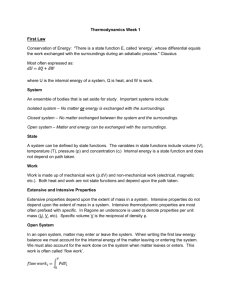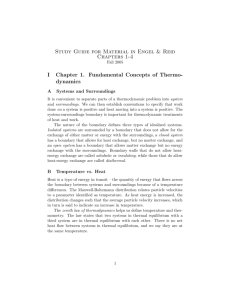Enthalpy/Specific Heat - Millersville Meteorology
advertisement
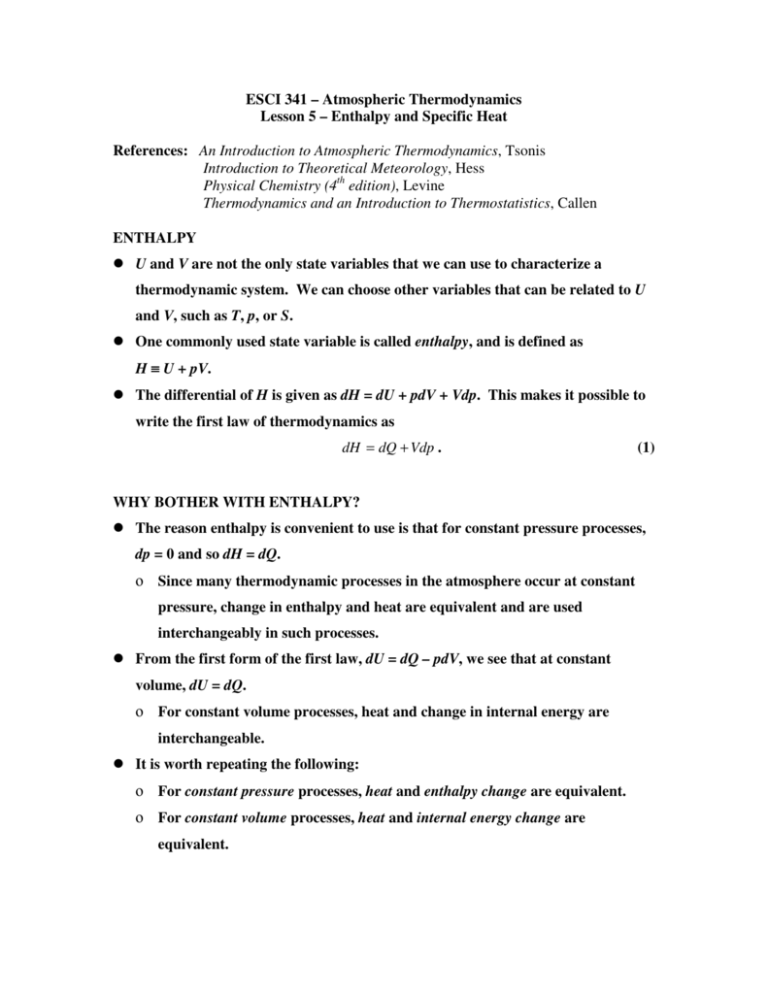
ESCI 341 – Atmospheric Thermodynamics Lesson 5 – Enthalpy and Specific Heat References: An Introduction to Atmospheric Thermodynamics, Tsonis Introduction to Theoretical Meteorology, Hess Physical Chemistry (4th edition), Levine Thermodynamics and an Introduction to Thermostatistics, Callen ENTHALPY U and V are not the only state variables that we can use to characterize a thermodynamic system. We can choose other variables that can be related to U and V, such as T, p, or S. One commonly used state variable is called enthalpy, and is defined as H ≡ U + pV. The differential of H is given as dH = dU + pdV + Vdp. This makes it possible to write the first law of thermodynamics as dH = dQ + Vdp . (1) WHY BOTHER WITH ENTHALPY? The reason enthalpy is convenient to use is that for constant pressure processes, dp = 0 and so dH = dQ. ο Since many thermodynamic processes in the atmosphere occur at constant pressure, change in enthalpy and heat are equivalent and are used interchangeably in such processes. From the first form of the first law, dU = dQ – pdV, we see that at constant volume, dU = dQ. ο For constant volume processes, heat and change in internal energy are interchangeable. It is worth repeating the following: ο For constant pressure processes, heat and enthalpy change are equivalent. ο For constant volume processes, heat and internal energy change are equivalent. One other important aspect of enthalpy is that in an isobaric (constant pressure) process, dW = dU − dH , which states that the work is the difference in the changes of internal energy and enthalpy. HEAT CAPACITIES AND SPECIFIC HEATS Heat capacity refers to the amount of heat required to raise the temperature of a substance by one degree. Heat capacity is defined in terms of either a constant volume process or a constant pressure process, ∂Q Cv ≡ ∂T v (2) ∂Q Cp ≡ . ∂T p (3) From the two forms of the first law we can show that ∂Q ∂U = ∂T v ∂T v ∂Q ∂H = ∂T p ∂T p so that the definitions for heat capacity can also be written as ∂U Cv ≡ ∂T v (4) ∂H Cp ≡ . ∂T p (5) The units of heat capacity are J K−1. Heat capacity is an extensive property. Its intensive counterpart is called specific heat, and is defined as cv ≡ cp ≡ Cv ∂u = m ∂T v (6) ∂h = . m ∂T p (7) Cp 2 The units of specific heat are J K−1 kg−1. Heat capacities and specific heats are not constant, but are functions of T and p. RELATION BETWEEN Cv AND Cp To see the relation between Cv and Cp we start with the relation ∂H ∂U C p − Cv = − . ∂T p ∂T v (8) From the definition of enthalpy, H = U + pV , we take the partial derivative with respect to T at constant pressure to get ∂H ∂U ∂V = + p . ∂T p ∂T p ∂T p (9) Substituting (9) into (8) we get ∂U ∂V ∂U C p − Cv = + p − . ∂T p ∂T p ∂T v (10) The differential of U is ∂U ∂U dU = dT + dV . ∂T V ∂V T Dividing by dT gives dU ∂U ∂U dV = . + dT ∂T V ∂V T dT and assuming constant pressure we get dU ∂U ∂U dV = + dT p ∂T V ∂V T dT p or ∂U ∂U ∂U ∂V = + . ∂T p ∂T V ∂V T ∂T p Substituting this into (10) gives 3 (11) ∂U ∂V C p − C v = + p ∂V T ∂T p . (12) In terms of specific heats this is ∂u ∂α c p − cv = + p . ∂α T ∂T p ο ( ∂U (13) ∂V )T [or ( ∂u ∂α )T ] is called the internal pressure, and is due to forces between the molecules of the substance. For gases, Cp is greater than Cv. This is because in a constant pressure process some of the heat added will be used to do work as the system expands, so the internal energy cannot increase as much as in a constant volume process. SPECIFIC HEATS FOR IDEAL GASES Recall that the specific heat at constant volume was defined as ∂u cv ≡ ∂T v And the specific heat at constant pressure was defined as ∂h cp ≡ ∂T p ο Since the internal energy and enthalpy of an ideal gas depend only on temperature, then for an ideal gas we don’t have to write the specific heats as partial derivatives, but can instead use full derivatives du dT . dh cp ≡ dT cv ≡ ο From the expressions for the internal energy of ideal gases, we then get that 3 R ′; monatomic gas 2 5 cv = R ′; diatomic gas 2 cv = 4 The expression relating the specific heats at constant pressure and at constant volume is also greatly simplified for an ideal gas. The general expression [Eqn. (13)] becomes, for an ideal gas, c p − cv = R ′ , (14) which tells us that 5 R ′; monatomic gas 2 7 c p = R ′; diatomic gas 2 cp = 99% of the atmosphere is composed of diatomic molecules (N2 and O2), and has a specific gas constant of 287.1 J-kg−1-K−1. This leads to values of cv and cp of 718 J-kg−1-K−1 and 1005 J-kg−1-K−1. These values are extremely close to the measured values for the atmosphere. THE FIRST LAW OF THERMODYNAMICS FOR IDEAL GASES The specific heats for ideal gasses are du dT . dh cp = dT cv = From these we can write du = cv dT dh = c p dT Using these expressions in the first law of thermodynamics results in the following two forms for the first law cv dT = dq − pdα c p dT = dq + α dp First Law of Thermodynamics for Ideal Gas We are often most interested in how the thermodynamic variables change with time. By dividing the first law by dt we get 5 dT dq dα = −p dt dt dt dT dq dp cp = +α dt dt dt cv First Law of Thermodynamics for Ideal Gas In meteorology, the most common form of the first law used the top equation above. There are many different symbols used for the heating term. Some common ways that you will see the first law written in other textbooks are DT dQ − αω = Dt dt DT Dα cv +p =J Dt Dt dT Dp −α = H cp dt Dt Cp Bluestein, (1992) Holton, (1992) Houze, (1993) . BEWARE: Not all textbooks use consistent notation. Many (such as Bluestein) use upper case “C” for specific heat. The first law is often referred to as the thermodynamic equation or thermodynamic energy equation. EXERCISES 1. Show that for an ideal gas ∂u ∂α c p − cv = + p ∂α T ∂T p reduces to c p − cv = R ′ . 2. Show that for an ideal gas Cp – Cv = nR. 6
